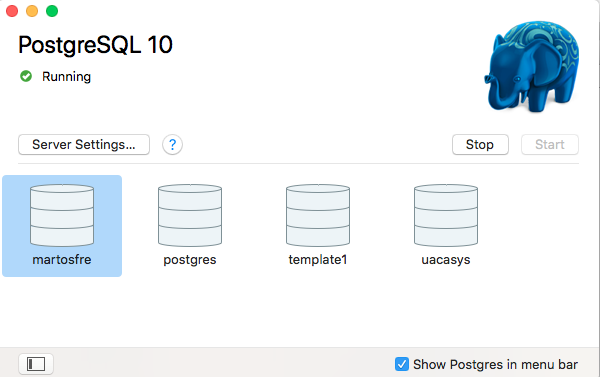

Even worse, the GRANT (and REVOKE) should be invoked…I guess at every level in our case. So we want the write privileges at the database level, but the roles are defined at the cluster level. Note that roles are defined at the database cluster level, and so are valid in all databases in the cluster. We will think in this way here as well.īy the way, if you wonder why handling the privileges for PostgreSQL is worth writing an article, here shows one of the reasons Many people use ROLE as a “group” role that contains multiple USER s. …The SQL standard leaves the definition of users to the implementation. The only difference is that when the command is spelled CREATE USER, LOGIN is assumed by default, whereas NOLOGIN is assumed when the command is spelled CREATE ROLE. But from the version 10 I am working with and onwards, the documentation clearly saysĬREATE USER is now an alias for CREATE ROLE. ROLE and USER in PostgreSQL can cause great confusion. Meanings of the arrows are explained by the demo below. We are gonna make use of PostgreSQL’s ROLE and USER combined to build a simple hierarchy that looks like this:ĭotted circles represent roles and solid circles represent our users. Doing bookkeeping for every user’s privilege is not a very clean solution. Besides, new people may come to the group and current researchers will leave at some point. For one there are actually more than five people in the group and there are more than two databases in our cluster. However, granting corresponding privileges to user1/2/3/4 is not a scalable solution. This StackOverflow post illustrates the burdensome work we have to handle.
#Postgres app not showing databases code#
If you read the documentation of GRANT, it sounds like the following code should solve half of our problem already GRANT CREATE, CONNECT, TEMPORARY ON DATABASE demo12 TO user1, user2 GRANT CREATE, CONNECT, TEMPORARY ON DATABASE demo34 TO user3, user4 There is no easy built-in solution in PostgreSQL. The “<” should be read as “is contained in”. Roughly speaking, we have table < schema < database < cluster in PostgreSQL. Side note: be careful of mixing up the concepts of “database” in PostgreSQL and MySQL. To sum up, we want the granularity for write access at the database level and for read access at the cluster level. We want to only allow people to write on their responsible databases under permission of the database admin. user1 and user2 are responsible for the database demo12. To better demonstrate our solution with code, assume for now we have only five people in the group.
#Postgres app not showing databases update#
We decided to constrain users’ privileges in the new server, and the database admin has to be informed when creation, deletion, and update happen. Ensuring everyone to make the right moves in the database cluster is practically impossible. The issues are greatly due to the fact that researchers in academia work very independently, and their primary concern is doing their own research project. So you see, even if nobody has the intention to corrupt the data in any way, because of lack of privilege management and clear guidelines to use the databases, people can easily turn the database cluster into a mess and maintaining the data becomes extremely difficult. From the first bullet point, you can see I have no idea whether such design is intentional or simply a mistake. a database has multiple schemas named as xyz-, with duplicated data across schemas.

some fields use types like varchar(n), but store only numeric values - I found that by doing pattern matching queries.This problem can be partially solved by tools like schemaspy and PostgreSQL’s own COMMENT. most databases are poorly documented and people have a hard time figuring it out the semantics of some old databases.The problems are exposed when I am asked to migrate the cluster to a new server and do some data cleaning before that.

Since it is a small group, essentially everyone has the right to read and modify the data. The use case I will talk about here is a database cluster where the users are the researchers in a research group. I used to downplay the importance of handling privileges for internal tools or at least misunderstand the intention of it.


 0 kommentar(er)
0 kommentar(er)
